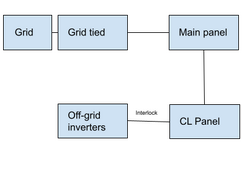solarhombre
New Member
Hi there,
I have solar panels connected to a grid-tied inverter that feed a breaker in my main electrical panel. An additional critical loads panel with a manual interlock is connected to 2xEG4 6500 and 6x EG4LLv2 batteries.
Now, imagine there's a grid outage. My grid tied stops producing energy and the house is powered by the batteries. After a day or two batteries are running low.
What would happen if I open the main breaker (disconnect from the grid) and bypass the interlock so that the EG4 inverters power the grid tied inverter? I have the feeling something will break if the power generated by the panels on the grid tied inverter cannot be absorbed by the load on the EG4 inverters, including battery charging.
I have solar panels connected to a grid-tied inverter that feed a breaker in my main electrical panel. An additional critical loads panel with a manual interlock is connected to 2xEG4 6500 and 6x EG4LLv2 batteries.
Now, imagine there's a grid outage. My grid tied stops producing energy and the house is powered by the batteries. After a day or two batteries are running low.
What would happen if I open the main breaker (disconnect from the grid) and bypass the interlock so that the EG4 inverters power the grid tied inverter? I have the feeling something will break if the power generated by the panels on the grid tied inverter cannot be absorbed by the load on the EG4 inverters, including battery charging.




